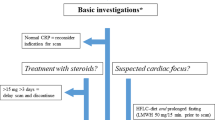Abstract
Background
Sclerotic bone lesions are often seen on chest CT in adults with tuberous sclerosis complex.
Objective
To characterize bone lesions at abdominal MRI in children with tuberous sclerosis complex.
Materials and methods
This retrospective review included 70 children with tuberous sclerosis complex who had undergone abdominal MRI for renal imaging. An additional longitudinal study was performed in 50 children who had had two or more MRI scans. Abdominal CT (eight children) and radiographs (three children) were reviewed and compared with MRI.
Results
A total of 173 sclerotic bone lesions were detected in 51/70 children (73%; 95% confidence interval: 0.61–0.82) chiefly affecting vertebral pedicles. New lesions appeared in 20 children and growth of previous sclerotic bone lesions was documented in 14 children. Sclerotic bone lesions were more frequent in girls and in children with more extensive renal involvement.
Conclusion
Sclerotic bone lesions are commonly detected by abdominal MRI in children with tuberous sclerosis complex. They usually affect posterior vertebral elements and their number and size increase with age. As current recommendations for tuberous sclerosis complex surveillance include renal MR performed in childhood, recognition of these lesions is useful.




Similar content being viewed by others
References
Crino PB, Nathanson KL, Henske EP (2006) The tuberous sclerosis complex. N Engl J Med 355:1345–1356
Roach ES, Gomez MR, Northrup H (1998) Tuberous sclerosis complex consensus conference: revised clinical diagnostic criteria. J Child Neurol 13:624–628
Northrup H, Krueger DA, International Tuberous Sclerosis Complex Consensus Group (2013) Tuberous sclerosis complex diagnostic criteria update: recommendations of the 2012 international tuberous sclerosis complex consensus conference. Pediatr Neurol 49:243–254
Avila NA, Dwyer AJ, Rabel A et al (2010) CT of sclerotic bone lesions: imaging features differentiating tuberous sclerosis complex with lymphangioleiomyomatosis from sporadic lymphangioleiomymatosis. Radiology 254:851–857
Stosic-Opincal T, Peric V, Lilic G et al (2005) Spine MRI findings in a patient with tuberous sclerosis: a case report--part II. Spine 30:992–993
Krueger DA, Northrup H, International Tuberous Sclerosis Complex Consensus Group (2013) Tuberous sclerosis complex surveillance and management: recommendations of the 2012 international tuberous sclerosis complex consensus conference. Pediatr Neurol 49:255–265
Evans JC, Curtis J (2000) The radiological appearances of tuberous sclerosis. Br J Radiol 73:91–98
Umeoka S, Koyama T, Miki Y et al (2008) Pictorial review of tuberous sclerosis in various organs. Radiographics 28:e32
Jonard P, Lonneux M, Boland B et al (2001) Tc-99m HDP bone scan showing bone changes in a case of tuberous sclerosis or Bourneville’s disease. Clin Nucl Med 26:50–52
Komar NN, Gabrielsen TO, Holt JF (1967) Roentgenographic appearance of lumbosacral spine and pelvis in tuberous sclerosis. Radiology 89:701–705
Song L, Zhang Y, Zhang W (2013) Bone scintigraphy may help differentiate bone sclerotic lesions from osteoblastic metastases in tuberous sclerosis patients with concomitant pulmonary adenocarcinoma. Clin Imaging 37:382–385
Holt JF, Dickerson WW (1952) The osseous lesions of tuberous sclerosis. Radiology 58:1–8
Boronat S, Shaaya E, Doherty C et al (2014) Tuberous sclerosis complex without tubers and subependymal nodules: a phenotype-genotype study. Clin Genet 86:149–154
Carsillo T, Astrinidis A, Henske EP (2000) Mutations in the tuberous sclerosis complex gene TSC2 are a cause of sporadic pulmonary lymphangioleiomyomatosis. Proc Natl Acad Sci U S A 97:6085–6090
Fang F, Sun S, Wang L et al (2015) Neural crest-specific TSC1 deletion in mice leads to sclerotic craniofacial bone lesion. J Bone Miner Res. doi:10.1002/jbmr.2447
Pui MH, Kong HL, Choo HF (1996) Bone changes in tuberous sclerosis mimicking metastases. Australas Radiol 40:77–79
Rodallec MH, Feydy A, Larousserie F et al (2008) Diagnostic imaging of solitary tumors of the spine: what to do and say. Radiographics 28:1019–1041
Onitsuka H (1977) Roentgenologic aspects of bone islands. Radiology 123:607–612
Bracken J, Nandurkar D, Radhakrishnan K et al (2013) Normal paediatric bone marrow: magnetic resonance imaging appearances from birth to 5 years. J Med Imaging Radiat Oncol 57:283–291
Author information
Authors and Affiliations
Corresponding author
Ethics declarations
Conflicts of interest
None
Rights and permissions
About this article
Cite this article
Boronat, S., Barber, I., Pargaonkar, V. et al. Sclerotic bone lesions at abdominal magnetic resonance imaging in children with tuberous sclerosis complex. Pediatr Radiol 46, 689–694 (2016). https://doi.org/10.1007/s00247-016-3549-3
Received:
Revised:
Accepted:
Published:
Issue Date:
DOI: https://doi.org/10.1007/s00247-016-3549-3




